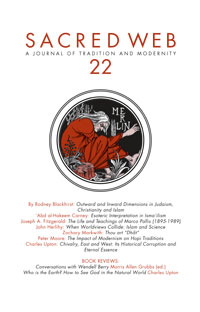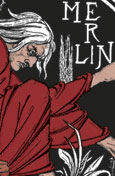Sacred Web 22
Editorial: Striving for “Wholeness” in the Kali Yuga
by M. Ali Lakhani
To be fully human is to exist in “wholeness”. Yet, the conditions of the Kali Yuga or the End Times make it difficult for man to achieve this. We need to rediscover the faith that can reconnect us to things, and, above all, to the Divine Presence who alone subsists and who is the ground of our being.
Outward and Inward Dimensions in Judaism,
Christianity and Islam, and Perspectives on Initiation
by Rodney Blackhirst
This article offers new but contentious perspectives on controversies regarding the esoteric/exoteric model as it applies to the monotheisms and especially to Christianity. The article seeks to define the “norms” of interior and exterior spiritual life in the context of “End Time” religions and argues that, in this respect, Islam is a return to the “norm” while Christianity and Judaism are (relatively speaking) deviations. Against quasi-masonic complaints that Christianity lacks a (Sufi-like) esoteric path the author presents the case that monastic perfection is the proper inner core of Christian spiritual life.
From Marco Pallis to Thubden Tendzin: A Son of Tibet Returns
by Joseph A. Fitzgerald
Marco Pallis (1895-1989) was a gifted musician, composer, mountaineer, translator, and a widely respected author on Tibetan Buddhism and the Perennial Philosophy. His eloquent writings focus on Buddhist doctrine and method, but are noteworthy for their universalist outlook. This article surveys Pallis’ life and work, and is presented in honor of the twentieth anniversary of his passing.
Chivalry, East and West:
Its Historical Corruption and Eternal Essence
by Charles Upton
Christian chivalry is connected with the Romance tradition, while Muslim chivalry is connected with Sufic conventions of courtesy. Both these are grounded in a deeper understanding of spiritual virtue and its obligations. Upton discusses this deeper meaning of chivalry conduct and how it has become corrupted in the context of the modern world. This essay is excerpted from Shadow of the Rose: The Esoterism of the Romantic Tradition, Sophia Perennis, 2008, by Charles Upton and Jennifer Doane Upton.
Thou art “Dhat”
by Zachary Markwith
This article surveys various metaphysical doctrines in Islam that closely correspond to Advaita Vedanta, including the esoteric commentaries on the shahadah (testimony of faith) and the Divine Name (Allah), verses from the Quran, and the Sunnah of the Prophet Muhammad (which includes his sayings or ahadith). In addition to examining the primary Islamic sources, this study also examines sayings of the Shi'ite Imams, the theophanic locutions of Sufis such as Bayazid al-Bastami and Mansur al-Hallaj, Arabic and Persian Sufi poetry, especially the poetry of ’Attar and Rumi,and the school of theoretical gnosis associated with figures such as Muhyi al-Din ibn al-’Arabi, ’Abd al-Karim Jili, and Sadr al-Din Shirazi. Through these sources, as well as the writings and commentaries of those men who revived the traditional understanding of the sophia perennis, such as René Guénon, Ananda K. Coomaraswamy, and Frithjof Schuon, this article demonstrates that the Infinite Reality or Self to which reference is made in the doctrine of Advaita Vedanta is also present and accessible through the esoteric, philosophical, and artistic dimensions of the Islamic tradition.
Esoteric Interpretation in Isma’ilism
by ‘Abd al-Hakeem Carney
This essay is excerpted from “An Introduction to Isma’ili Esoteric Interpretation”, written by the late ‘Abd al-Hakeem Carney to introduce his unpublished English translation of Kitab al-Kashf (The Book of Unveiling), an early Isma’ili treatise on the esoteric interpretation of the Qu’ran. It outlines the Isma’ili doctrine of ta’wil or esoteric interpretation, the role of the Isma’ili Imam as the interpreter and guide of the faithful, and the significance of the Isma’ili doctrine of qiyama or the Great Resurrection, which Carney relates to postmodern theories of linguistic deconstruction, viewing it as an apophatic deconstruction of ta’wil, paralleling the self-transcendence that is a necessary step in approaching the Absolute.
“Corn is Life”: Agriculture, Spiritual Life, and Economic Change among the Hopi
by Peter Moore
This case study of the Hopi corn culture in northeastern Arizona focuses on how the commodification of corn and the decline of subsistence farming has impacted the religious and cultural lives of the Hopi, how this impact parallels certain trends in Christian civilization in the West, and how it reflects a corresponding loss in the symbolic content of the sacred world and the decline of the traditional worldview that characterizes the “fallenness” of man.
When Worldviews Collide: Points of Departure
for Islamic Thought and Scientific Thought
by John Herlihy
This is a revised version of a talk delivered at Yale University in April 2008 for a conference on “Critical Islamic Reflections”, and deals with the theme of Traditional vs. Scientific Knowledge. Herlihy approaches his subject from the perspective of the scientia sacra of Tradition, examining the role of faith and reason in science and in Islam, exposing the limitations and biases inherent in closed systems of thought, and seeking a higher ground to reconcile apparent conflicts in epistemology by relating these to the perennialist quest for objectivity.
Book Reviews:
Conversations with Wendell Berry
Edited by Morris Allen Grubbs
Reviewed by M. Ali Lakhani
Who is the Earth? How to See God in the Natural World
by Charles Upton
Reviewed by M. Ali Lakhani
Notes on Contributors




